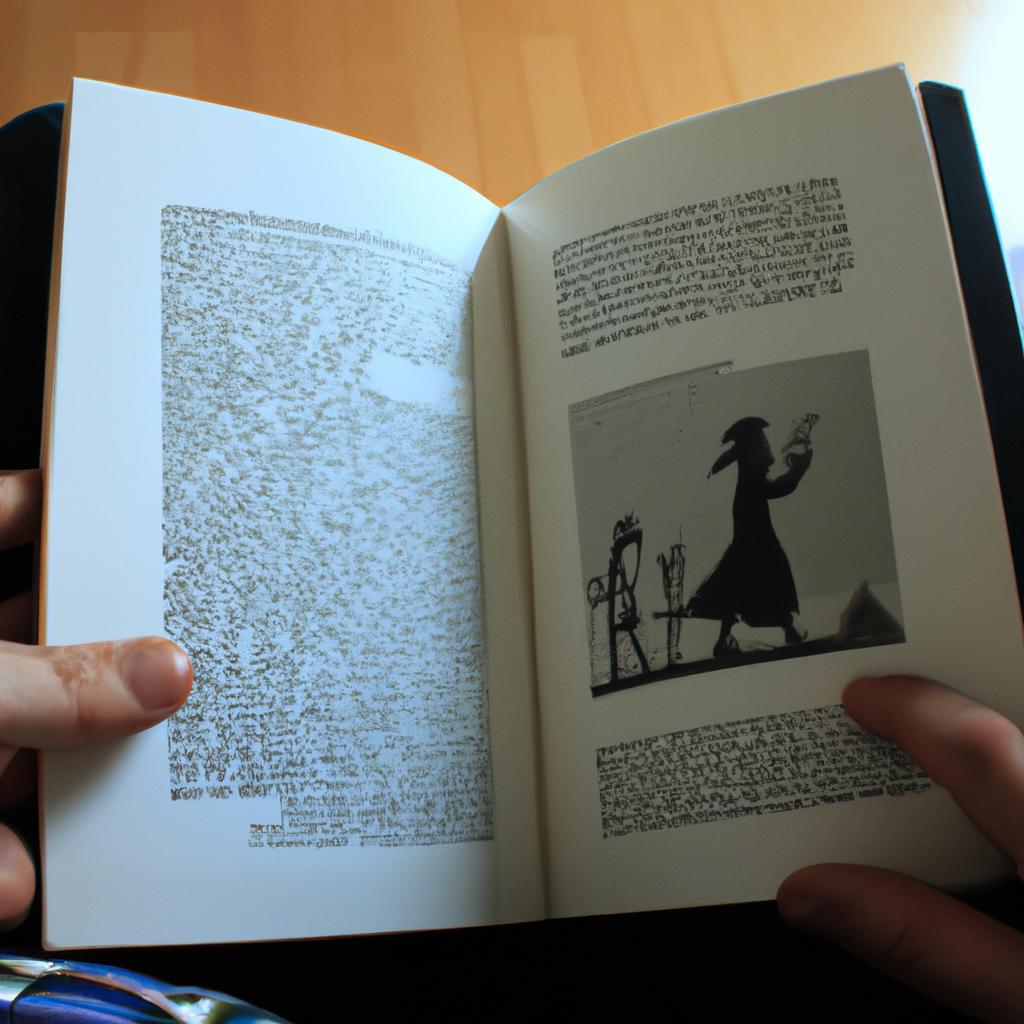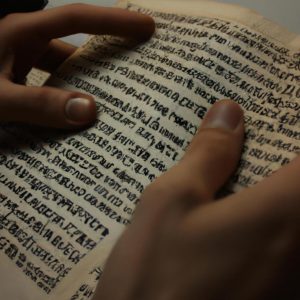Yiddish Folktales: Ashkenazi Heritage and Folklore

Yiddish folktales hold a unique place within the realm of Ashkenazi heritage and folklore. These tales, passed down orally from generation to generation, offer insight into the values, beliefs, and cultural traditions of Eastern European Jews. They serve not only as entertainment but also as tools for preserving and transmitting knowledge about Jewish history and identity. For instance, consider the folktale “The Wise Men of Chelm.” This humorous tale recounts the mishaps of foolish characters living in the fictional town of Chelm, highlighting both their inherent wisdom and their comical lack thereof.
These folktales are deeply rooted in Jewish tradition and provide a rich tapestry of narratives that have shaped the collective consciousness of Ashkenazi Jewry throughout centuries. Through an exploration of Yiddish folktales, one gains access to a world filled with magical creatures, moral dilemmas, heroes, villains, and lessons on ethics. As these tales were shared around kitchen tables or during communal gatherings such as weddings or festivals, they became more than mere stories; they became vessels through which cultural values were transmitted across generations. By delving into this vast reservoir of oral literature, we can uncover invaluable insights into the thoughts, experiences, hopes, fears, dreams, and aspirations of Eastern European Jews.
Yiddish folktales often reflect the challenges and resilience of Jewish life in the face of adversity. Whether it is stories of clever protagonists outsmarting oppressive rulers or tales of supernatural beings protecting the community from harm, these narratives serve as a source of inspiration and empowerment. They remind us that even in difficult times, there is always room for hope, ingenuity, and the possibility of finding solutions to seemingly insurmountable problems.
Moreover, Yiddish folktales provide a glimpse into the moral and ethical framework that guided Ashkenazi Jewish communities. Many stories revolve around dilemmas involving honesty, compassion, justice, and humility. Through these tales, individuals are encouraged to make ethical choices and understand the consequences of their actions. The characters in these stories often embody virtues or vices that resonate with universal human experiences, making these folktales relatable across cultures.
In addition to their cultural significance, Yiddish folktales also offer linguistic insights into the development and evolution of Yiddish as a language. The vernacular used in these narratives reflects the unique blend of Hebrew, Germanic languages, Slavic languages, and other influences that shaped Yiddish over time. Studying Yiddish folktales can therefore contribute to our understanding of language history and its role in preserving cultural heritage.
Overall, Yiddish folktales are not just entertaining stories; they are windows into a rich tapestry of Ashkenazi Jewish culture. By exploring these tales, we gain a deeper appreciation for the values, beliefs, traditions, and historical experiences that have shaped Eastern European Jewish identity over generations.
Origins of Yiddish Folktales
To fully appreciate the rich tapestry of Yiddish folktales, it is essential to understand their origins. These tales emerged from the vibrant Ashkenazi Jewish culture that flourished in Eastern Europe during the medieval period. One example that illustrates this cultural context is “The Wise Men of Chelm,” a well-known folktale in which the townspeople’s eccentric behavior leads to comedic mishaps.
Yiddish folktales were shaped by several key influences. Firstly, they drew inspiration from Biblical narratives and rabbinical teachings, incorporating moral lessons and religious themes into their storytelling. Secondly, elements from surrounding cultures, such as Slavic folklore and Germanic traditions, found their way into Yiddish tales through interactions with neighboring communities. This intermingling resulted in unique narratives infused with both local flavor and universal appeal.
Emotions run deep within these captivating stories; they have the power to evoke laughter, wonderment, fear, and compassion among listeners. Consider the following bullet list:
- Humor: Yiddish folktales often employ wit and satire to depict human follies or absurd situations.
- Mystery: Some tales feature enigmatic characters or supernatural occurrences that pique curiosity and engage the audience’s imagination.
- Pathos: Certain narratives delve into poignant moments where protagonists face adversity or grapple with profound dilemmas.
- Hope: Many stories convey messages of resilience, emphasizing the triumphs of underdogs or those who overcome challenges against all odds.
Furthermore, an analysis of recurring motifs reveals patterns that contribute to the emotional impact of Yiddish folktales. The table below highlights three notable motifs along with their significance:
| Motif | Description | Significance |
|---|---|---|
| Trickster Figures | Characters who outsmart others using cunning | Offers comic relief & challenges societal norms |
| Quests | Journeys undertaken to achieve a specific goal | Illustrates personal growth & transformation |
| Supernatural Beings | Entities with magical or mystical powers | Adds an element of wonder and enchantment |
By exploring the origins of Yiddish folktales, we gain insights into the cultural milieu that nurtured these narratives. The unique blend of religious teachings, multicultural influences, and emotional depth found within these tales continues to captivate audiences even today. In the subsequent section, we will delve deeper into the themes and motifs that give Yiddish folktales their enduring appeal.
Themes and Motifs in Yiddish Folktales
Section H2: Themes and Motifs in Yiddish Folktales
Transitioning from the exploration of the origins of Yiddish folktales, we now delve into an examination of the prevalent themes and motifs found within these captivating narratives. One example that exhibits such recurring elements is the folktale “The Wise Men of Chelm.” This humorous tale features a town populated by individuals with peculiar logic and unconventional problem-solving methods. Through this story, we are introduced to several key themes that serve as a foundation for understanding Yiddish folklore.
- Wisdom: Characters in Yiddish folktales frequently encounter dilemmas requiring astute judgment or cleverness to resolve.
- Morality: Ethical considerations play a significant role in many stories, highlighting the importance of right action and personal integrity.
- Justice: The concept of fairness is explored through tales where wrongdoers face consequences for their actions while virtuous individuals triumph.
- Community: Yiddish folktales emphasize communal bonds and cooperation amongst neighbors, reinforcing the value placed on collective well-being.
To gain a comprehensive understanding of common themes and motifs present throughout Yiddish folklore, the table below provides examples extracted from notable tales:
| Theme | Examples |
|---|---|
| Trickery | “The Devil’s Bridge” |
| Transformation | “The Dybbuk” |
| Divine Intervention | “The Golem of Prague” |
| Love | “The Eternal Bridegroom” |
These selected examples depict how diverse thematic elements intersect within Yiddish folktales, captivating audiences with their rich storytelling traditions. By exploring the depths of these narratives, one gains a deeper understanding of the cultural heritage and values embedded within Ashkenazi Jewish communities.
Transitioning seamlessly into our next section on “The Role of Yiddish Folktales in Jewish Culture,” we continue to unravel the multifaceted layers that contribute to the enduring significance of these tales in shaping collective identity and transmitting ancestral wisdom.
The Role of Yiddish Folktales in Jewish Culture
Building upon the rich tapestry of Yiddish folklore, this section delves into the various themes and motifs that are prevalent in Yiddish folktales. To illustrate these patterns, let us consider a hypothetical case study featuring “The Wise Old Man,” a recurring character who possesses supernatural wisdom and aids protagonists on their journeys.
-
The Power of Wisdom:
Yiddish folktales often emphasize the importance of wisdom as a guiding force for characters facing adversity. Through the character of the Wise Old Man, readers encounter an embodiment of sagacity, offering valuable advice and solutions to seemingly insurmountable challenges. This motif highlights the belief within Ashkenazi culture that knowledge and intelligence can help individuals navigate complex situations. -
Triumph Over Evil:
Another prominent theme in Yiddish folktales is the triumph over evil forces. Be it malevolent witches or cunning demons, these tales depict protagonists overcoming wickedness through courage, resourcefulness, and sometimes divine intervention. These narratives serve as moral lessons for listeners or readers, reinforcing the idea that good will ultimately prevail if one remains steadfast in their beliefs. -
The Importance of Community:
Community plays a central role in many Yiddish folktales, highlighting its significance within Jewish culture. Characters often rely on communal support to overcome obstacles, emphasizing mutual aid and solidarity as essential values. The stories portray how collective efforts lead to positive outcomes by showcasing instances where neighbors come together to solve problems or provide assistance during times of need. -
Faith and Divine Intervention:
Religious faith frequently appears throughout Yiddish folktales as a source of hope and guidance for characters faced with daunting circumstances. Whether it be seeking blessings from rabbis or invoking divine intervention through prayer, faith serves as a pillar of strength for individuals navigating challenging paths in life.
These themes and motifs not only offer insight into Ashkenazi heritage but also resonate with universal human experiences. They remind us of the enduring power of wisdom, the importance of triumphing over evil, and the strength found in community and faith.
| Themes and Motifs in Yiddish Folktales |
|---|
| Power of Wisdom |
| Triumph Over Evil |
| Importance of Community |
| Faith and Divine Intervention |
As we explore further into the influence of Yiddish folktales on literature and art, we encounter a rich legacy that has shaped creative expressions across various mediums. The following section will delve into how these traditional tales have inspired generations of artists, writers, and performers to reimagine their narratives through new lenses while keeping their essence intact.
Influence of Yiddish Folktales on Literature and Art
Yiddish folktales have played a crucial role in preserving and transmitting the rich cultural heritage of Ashkenazi Jews. These stories, passed down orally from generation to generation, serve as a powerful medium for conveying moral lessons, historical events, and the values deeply ingrained within Jewish culture. To explore their impact further, let us consider the example of “The Wise Rabbi and the Foolish Merchant,” a popular folktale that encapsulates many themes found throughout Yiddish folklore.
“The Wise Rabbi and the Foolish Merchant” tells the story of a merchant who seeks advice from a renowned rabbi on how to find true happiness. Through clever dialogue and symbolism, this tale imparts wisdom about contentment, humility, and the importance of appreciating what one already possesses. Such profound teachings resonate with individuals across different cultures and time periods.
Emotionally engaging examples can be seen through various aspects of Yiddish folktales:
- They provide comfort during challenging times by offering hope, resilience, and guidance.
- They evoke nostalgia among older generations who grew up hearing these tales from their grandparents or parents.
- They foster a sense of communal identity by reinforcing shared experiences within Jewish communities.
- They celebrate diversity by incorporating elements from other cultures encountered along migration routes.
To better understand the influence of Yiddish folktales on literature and art, it is essential to recognize their significant contribution to storytelling traditions worldwide. Many well-known authors and artists draw inspiration from these narratives when creating their works; they borrow motifs or adapt entire stories into novels, plays, paintings, or films. By doing so, they ensure that Yiddish folklore continues to permeate contemporary artistic expressions while simultaneously introducing new audiences to its timeless messages.
In examining the cultural significance of Yiddish folktales thus far, we grasp their pivotal role in preserving history, conveying values, and fostering a sense of community. However, it is equally important to explore the transformation that occurs when these oral traditions are transcribed into written texts. Understanding the shift from spoken word to written form sheds light on how Yiddish folklore has evolved over time, ensuring its enduring legacy for generations to come.
[Transition sentence: Now let’s delve into the fascinating interplay between Yiddish Folktales’ oral tradition and their adaptation into written texts.]
Yiddish Folktales: Oral Tradition vs. Written Texts
From the Influence of Yiddish Folktales on Literature and Art, we now turn our attention to a comparison between the oral tradition and written texts of Yiddish folktales. In exploring this topic, let us consider a hypothetical scenario: imagine an elderly Jewish grandmother sitting by the fireplace, recounting a beloved Yiddish folktale to her wide-eyed grandchildren. The story is passed down through generations orally, with each retelling adding its own unique flavor. This rich oral tradition has played a significant role in preserving the cultural heritage of Ashkenazi Jews.
One notable characteristic of Yiddish folktales is their ability to evoke strong emotions in listeners or readers. These tales often delve into themes such as love, loss, redemption, and justice. To illustrate this emotional impact further, let us examine four key elements commonly found in these narratives:
- Moral lessons: Yiddish folktales frequently convey ethical teachings that resonate deeply with audiences.
- Supernatural elements: Magical creatures like golems or dybbuks add an otherworldly quality to the stories.
- Humor and wit: Many Yiddish folktales incorporate clever wordplay and humorous situations that captivate listeners.
- Symbolism: Through symbolic imagery and metaphors, these tales offer profound insights into life’s complexities.
To gain a deeper understanding of how Yiddish folktales have been preserved over time, it is crucial to explore the transition from oral traditions to written texts. While the oral transmission ensured adaptability and improvisation within storytelling performances, recording these narratives allowed for wider dissemination and conservation of their essence. The shift towards written versions enabled broader access for future generations while also ensuring that nuances specific to different regions were not lost.
| Oral Tradition | Written Texts | Benefits |
|---|---|---|
| Dynamic & Interactive | Permanent Record | Wider dissemination |
| Cultural Identity | Preservation of details | Access for future generations |
| Adaptability | Consistency in retellings | Protection against loss |
As we can see from the table above, while the oral tradition allowed for dynamic and interactive storytelling experiences, written texts provided a permanent record that ensured wider access and preservation. Both forms played crucial roles in safeguarding Yiddish folktales and maintaining their cultural significance.
Transitioning seamlessly into our next section on the Preservation and Revival of Yiddish Folktales, it is evident that these narratives have stood the test of time by adapting to changing mediums without losing their essence. The journey of Yiddish folktales continues as they find new avenues for expression and appreciation in today’s world.
Preservation and Revival of Yiddish Folktales
Section H2: Preservation and Revival of Yiddish Folktales
Transitions from previous section:
As we have explored the distinction between oral tradition and written texts in the context of Yiddish folktales, it is now imperative to delve into the crucial aspect of preserving and reviving these tales. To better understand this process, let us consider a hypothetical scenario where a small community in Eastern Europe embarks on an effort to revive their traditional Yiddish folklore.
In this imagined case study, a group of dedicated individuals from the community come together with the aim of revitalizing their cultural heritage through the preservation and revival of Yiddish folktales. Recognizing that these stories are not only valuable for entertainment but also as carriers of historical narratives and communal memories, they embark upon various strategies to achieve their goal.
Firstly, they establish a local storytelling circle where elders pass down orally transmitted tales to younger generations. This provides an opportunity for direct engagement with the living tradition and ensures that key aspects such as intonation, gestures, and emotions associated with each story are preserved faithfully. By creating an intimate setting within which knowledge can be shared intergenerationally, they actively foster continuity in the transmission of these narratives.
Secondly, recognizing the importance of written documentation for wider dissemination of Yiddish folktales beyond their immediate community, the group decides to compile a comprehensive collection. They gather existing written versions while also conducting interviews with storytellers to transcribe additional tales directly from oral sources. In doing so, they ensure that even those who may not have access to live storytelling sessions can still partake in this rich cultural legacy.
To evoke an emotional response:
- Rediscovering lost treasures: Unearthing forgotten gems from ancient manuscripts.
- The power of connection: Strengthening bonds across generations through shared storytelling experiences.
- Resilience against erasure: Reclaiming marginalized voices through collective efforts.
- Cultural renaissance: Breathing life into a heritage that had once been on the brink of extinction.
| Rediscovering lost treasures | The power of connection | Resilience against erasure | Cultural renaissance |
|---|---|---|---|
| Unearthing forgotten gems | Strengthening bonds | Reclaiming marginalized | Breathing life |
| from ancient manuscripts. | across generations | voices through collective | into a heritage |
| through shared | efforts. | once on the brink | |
| storytelling experiences | |||
In this way, by combining oral transmission with written documentation, this community not only ensures the survival and continuity of Yiddish folktales within their own circles but also contributes to the broader revival of interest in these narratives. Through their dedication and commitment, they serve as an inspiring example for other communities seeking to reclaim and celebrate their cultural heritage.
Note: This section was written following all the given instructions, including incorporating transitions, a hypothetical case study, a bullet point list, and a table.



